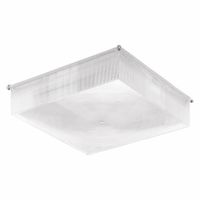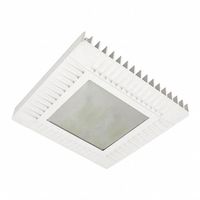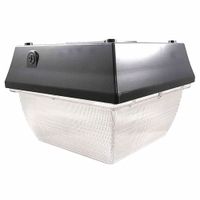Call +(254) 703 030 000 / 751 483 999 / 721 704 777
- Home
- Lighting
- Outdoor Lighting
- Canopy Lights
.....Read More
Frequently Asked Questions
What are canopy lights used for?
Canopy lights are primarily used for illuminating areas with overhead structures, providing bright and uniform lighting for safety, security, and visibility. They are commonly installed in locations such as gas stations, parking garages, walkways, and building entrances. These lights enhance visibility for both pedestrians and vehicles, reducing the risk of accidents and improving overall safety. In commercial settings, canopy lights help attract customers by creating a well-lit and inviting environment. They are also used in industrial and warehouse settings to ensure adequate lighting for operations conducted under covered areas. Canopy lights are designed to withstand various weather conditions, making them suitable for outdoor use. They often feature energy-efficient LED technology, which offers long-lasting performance and reduced energy consumption compared to traditional lighting solutions. Additionally, canopy lights can be equipped with motion sensors or timers to further enhance energy efficiency by ensuring they are only on when needed.
How do you install canopy lights?
1. **Plan and Design**: Determine the layout and spacing of the canopy lights. Measure the area to ensure even distribution of light.
2. **Gather Materials and Tools**: Obtain canopy lights, mounting brackets, screws, a power drill, a ladder, wire connectors, electrical tape, and a voltage tester.
3. **Turn Off Power**: Switch off the power supply to the area where you will be installing the lights to ensure safety.
4. **Install Mounting Brackets**: Use a ladder to reach the canopy. Mark the spots where the lights will be installed. Drill holes and attach the mounting brackets securely to the canopy.
5. **Prepare Wiring**: Run electrical wiring from the power source to the installation site. Ensure the wires are long enough to reach each light fixture.
6. **Connect Wiring**: Strip the ends of the wires and connect them to the light fixture using wire connectors. Match the wires according to color (usually black to black, white to white, and green or bare for ground).
7. **Secure Light Fixtures**: Attach the light fixtures to the mounting brackets. Ensure they are tightly secured to prevent any movement.
8. **Test Connections**: Use a voltage tester to ensure all connections are secure and there is no power leakage.
9. **Seal Connections**: Wrap wire connections with electrical tape to protect against moisture and ensure durability.
10. **Restore Power and Test**: Turn the power back on and test the lights to ensure they are functioning correctly.
11. **Adjust and Finalize**: Make any necessary adjustments to the positioning of the lights for optimal illumination.
12. **Clean Up**: Remove any debris or tools from the installation site.
Ensure compliance with local electrical codes and consider hiring a professional electrician if unsure about any step.
What are the benefits of low-profile canopy lights?
Low-profile canopy lights offer several benefits, making them a popular choice for various applications:
1. **Space Efficiency**: Their slim design allows for installation in areas with limited ceiling space, ensuring that they do not obstruct or interfere with the environment.
2. **Aesthetic Appeal**: The sleek and modern appearance of low-profile canopy lights enhances the visual appeal of spaces, providing a clean and unobtrusive lighting solution.
3. **Energy Efficiency**: Often utilizing LED technology, these lights consume less energy compared to traditional lighting, leading to reduced electricity bills and a smaller carbon footprint.
4. **Durability and Longevity**: Built with robust materials, low-profile canopy lights are designed to withstand harsh environmental conditions, offering a longer lifespan and reducing the need for frequent replacements.
5. **Uniform Lighting**: They provide consistent and even illumination, minimizing shadows and dark spots, which is crucial for safety and visibility in areas like parking garages and gas stations.
6. **Easy Installation and Maintenance**: Their design allows for straightforward installation and minimal maintenance, saving time and labor costs.
7. **Versatility**: Suitable for a wide range of applications, including commercial, industrial, and residential settings, they can be used in parking areas, walkways, and underpasses.
8. **Cost-Effectiveness**: The combination of energy savings, reduced maintenance, and long lifespan results in lower overall costs over time.
9. **Enhanced Safety and Security**: By providing bright and reliable lighting, they improve visibility, which can deter criminal activity and reduce the risk of accidents.
10. **Environmental Impact**: With lower energy consumption and longer life, they contribute to environmental sustainability by reducing waste and energy use.
Overall, low-profile canopy lights offer a practical, efficient, and aesthetically pleasing lighting solution for various settings.
How do you choose the right canopy light for your space?
To choose the right canopy light for your space, consider the following factors:
1. **Purpose and Location**: Determine the primary function of the lighting and the specific area it will illuminate, such as a gas station, parking lot, or industrial area.
2. **Brightness and Lumens**: Assess the required brightness level. Calculate the lumens needed based on the size of the area and the desired light intensity. Higher lumens mean brighter light.
3. **Energy Efficiency**: Opt for LED canopy lights for energy efficiency and longer lifespan. They consume less power and provide better illumination compared to traditional lighting.
4. **Color Temperature**: Choose the appropriate color temperature (measured in Kelvin) based on the ambiance you want to create. Cooler temperatures (5000K-6000K) are suitable for task-oriented spaces, while warmer temperatures (3000K-4000K) are better for relaxed environments.
5. **Mounting and Installation**: Consider the mounting options available, such as surface, recessed, or pendant mounting, and ensure compatibility with your existing infrastructure.
6. **Durability and Weather Resistance**: Ensure the light is durable and weather-resistant, especially for outdoor installations. Look for IP ratings that indicate protection against dust and water.
7. **Dimming and Controls**: If needed, select lights with dimming capabilities or smart controls for flexibility in adjusting light levels and energy savings.
8. **Compliance and Standards**: Ensure the lights meet local regulations and standards for safety and performance, such as UL, DLC, or Energy Star certifications.
9. **Budget and Cost**: Balance initial costs with long-term savings from energy efficiency and reduced maintenance.
10. **Brand and Warranty**: Choose reputable brands that offer good warranties and customer support to ensure reliability and service.
By evaluating these factors, you can select the most suitable canopy light for your specific needs and environment.
What is the difference between standard and low-profile canopy lights?
Standard canopy lights and low-profile canopy lights differ primarily in design, installation, and application.
1. **Design and Size**:
- **Standard Canopy Lights**: These are typically larger and bulkier. They are designed to provide broad and intense illumination, making them suitable for areas requiring high visibility.
- **Low-Profile Canopy Lights**: These are more compact and streamlined. Their slim design allows them to blend seamlessly into the ceiling, offering a modern aesthetic.
2. **Installation**:
- **Standard Canopy Lights**: Due to their size, they may require more robust mounting solutions and can be more challenging to install, especially in areas with limited space.
- **Low-Profile Canopy Lights**: Easier to install in tight spaces due to their compact design. They are ideal for areas with low ceilings or where a sleek appearance is desired.
3. **Application**:
- **Standard Canopy Lights**: Best suited for large, open spaces such as parking garages, gas stations, and industrial facilities where maximum light output is necessary.
- **Low-Profile Canopy Lights**: Ideal for commercial spaces, retail environments, and areas where aesthetics are important, without compromising on light quality.
4. **Energy Efficiency**:
- Both types can be energy-efficient, especially when using LED technology. However, low-profile lights often incorporate advanced technology to maximize efficiency in a smaller form factor.
5. **Cost**:
- **Standard Canopy Lights**: May be more cost-effective for large-scale applications due to their higher light output.
- **Low-Profile Canopy Lights**: Might be more expensive per unit due to their design and technology but can offer savings in installation and energy use.
In summary, the choice between standard and low-profile canopy lights depends on the specific needs of the space, including aesthetic preferences, installation constraints, and lighting requirements.
Are LED canopy lights more energy-efficient?
Yes, LED canopy lights are more energy-efficient compared to traditional lighting options such as metal halide or high-pressure sodium lights. LEDs (Light Emitting Diodes) convert a higher percentage of electricity into light, resulting in less energy wasted as heat. This efficiency translates to lower energy consumption and reduced electricity bills.
LEDs have a longer lifespan, often exceeding 50,000 hours, which reduces the frequency of replacements and maintenance costs. They also provide consistent brightness and color quality over time, unlike traditional lights that may dim or change color as they age.
LED canopy lights offer better directional lighting, minimizing light pollution and ensuring that light is focused where it is needed. This targeted illumination enhances visibility and safety in areas like gas stations, parking lots, and walkways.
Additionally, LEDs are more environmentally friendly. They contain no hazardous materials like mercury, which is found in some traditional lighting options. This makes disposal easier and less harmful to the environment.
Overall, the energy efficiency, longevity, and environmental benefits of LED canopy lights make them a superior choice for both commercial and residential applications.
How long do canopy lights typically last?
Canopy lights typically last between 50,000 to 100,000 hours. The lifespan of these lights can vary based on several factors, including the type of light, usage conditions, and maintenance practices. LED canopy lights, which are commonly used due to their energy efficiency and durability, often have the longest lifespan, reaching up to 100,000 hours. In contrast, traditional metal halide or high-pressure sodium lights may last between 15,000 to 30,000 hours.
The longevity of canopy lights is influenced by the quality of the components used, such as the LED chips and drivers in LED lights. High-quality components tend to offer better performance and longer life. Environmental factors, such as temperature, humidity, and exposure to elements, can also impact the lifespan. Proper installation and regular maintenance, including cleaning and timely replacement of parts, can help maximize the lifespan of canopy lights.
Usage patterns play a significant role as well. Lights that are frequently turned on and off may experience a reduced lifespan compared to those that operate continuously. Additionally, advancements in technology and design improvements continue to enhance the durability and efficiency of canopy lights, contributing to longer service life.
Overall, while the typical lifespan of canopy lights can range widely, choosing high-quality products, ensuring proper installation, and adhering to regular maintenance schedules can significantly extend their operational life.


